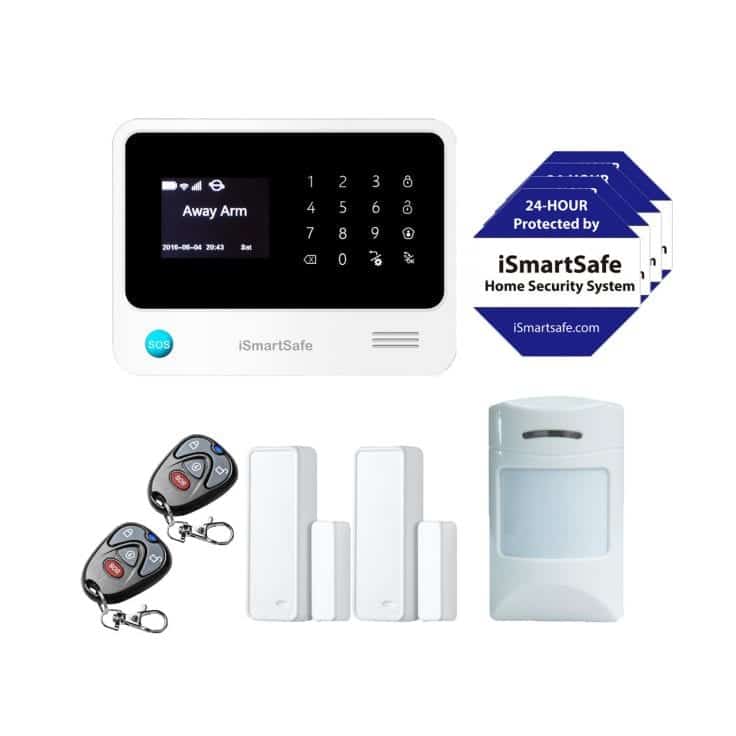Security is a top priority in every home, but your budget is sometimes a little tighter than you wish. Home security systems can overwhelm you with startup costs and monthly monitoring fees. But do not be discouraged, I can help you start with a very effective basic security system that works wonderfully without any monthly fees!
What is the best minimum setup for a home security system?
The following equipment as part of a home security system will provide you with basic yet effective home security:
- Security system decals and signs
- Base security system hub
- Two entry sensors
- One motion sensor
Keep reading to learn why these parts are essential for safety. I will help you put together a robust home security system that costs less than $200, has Wi-Fi and cellular connections, and no monthly fees!
The Components you need for an effective Home Security System at Minimal Cost
1. Place Security System Decals and Signs Around Your Property
Let’s start with something simple. According to a 2018 report from WTOP News in Washington, D.C., more than 400 incarcerated burglars stated that security signs were among the top ten security measures they were concerned about.
Most home burglars are impulsive opportunists who would opt for the neighbor’s house if they see a security system sign on your front yard or decals on your windows. After all, a burglar looks for an easy and quick way into and out of the house for theft.
Some homeowners only buy the sign and not the actual security system. I don’t personally recommend this. If a burglar specifically targets you, they will do their research and spend days watching your home. They won’t be scared off by a sign. It would be best if you had a more robust deterrent.
Which Security System Decal or Yard Sign Should I get?
Get a generic security system yard signs and decals. Generic is best for two reasons:
First, if you have an ADT or a Ring security system sign on your front yard, but you don’t own this system, you may be harassed by the local rep and liable for violating copyright law.
Second, and more importantly, all security systems have some vulnerability. If you advertise which system you own, a determined thief may target your system’s weakness. Your best protection is to give the burglar as little information as possible about your system. Keep your signs and decals generic. Here is a link to a sign and decal package that I recommend from Amazon (it signs for your front and back yards, and decals for windows and doors).
2. Choose a Base for Your Security System
Sometimes called a system hub or a system panel, this base unit is the most essential part of any home security setup. It is the brains of your system and usually the most expensive part. All the other sensors have to communicate with the base unit, so this is the time to choose which brand you like.
Some home alarm companies offer you “a free base with multiple free sensors,” but be careful; these offers are always attached to a multi-year monitoring commitment. If you sign the contract, you could pay as much as $20 to $50 a month for monitoring services in most instances!
Are there home alarm systems with no monthly fees?
Yes, while many companies try to sell you multi-year contracts, there are a few who have contract-free security systems with no mandatory extra services. iSmartSafe is a great pick. It comes with no contracts and is very easy to set up. The iSmartSafe system panel acts as the base unit. It connects to a power outlet and links to your Wi-Fi internet.

The iSmartSafe system panel has an LED display and can be paired with iSmartSafe indoor or outdoor cameras, motion sensors, entry sensors, remote keypad, smoke alarms, or water leak sensors. You can custom build a whole home security system using iSmartSafe alone (more on that later). The panel will emit an ear-piercing siren if an intruder enters your property or when any sensor is triggered. You will also receive a notification on your phone specifying which sensor caused the alarm.
3. Add One or Two Entry Sensors
Now that you’ve got your central security panel, you want to add a few more pieces of equipment to guard your home or business. One of these is an entry sensor for your main door.
Entry sensors are two-part battery-operated devices: a transmitter and a magnet. The transmitter is wide, while the magnet is far slimmer. If someone tries to break through a secured door, the magnet moves, activating the alarm. Your entry sensor works in conjunction with your security system base, which will begin blaring the alarm, contacting you via your cell phone, and the police (if you have monthly monitoring).
Make sure you choose an entry sensor from the same company as your system base, because the sensors need to communicate with your main panel.
Should I get an entry sensor for each door and window in my home?
Ideally, yes. In a complete security system, you would have an entry sensor for each outside door and window. However, in a basic setup, I recommend only equipping your front door and back door (or sliding patio door) depending on which is most vulnerable. Luckily, there is a way to protect multiple doors and windows without the need for multiple entry sensors. One strategically placed motion sensor can replace 3 or 4 entry sensors.
4. Add a Strategically Placed Motion Sensor
The final piece of equipment for your starter home security setup is a motion sensor. These also pair with your home security system panel, so you’ll want to shop the same brand. Motion sensors can pick up movement up to 35 feet away. Most motion sensors have a wide-angle field of vision, so if you install your sensor in the corner of the room, it will cover any movement in that room. iSmartSafe uses more precise motion sensors to ensure your pets won’t trigger your alarms.
Congrats! Here is Your Complete System!
A basic home security setup might be simple, but it can be very effective if designed right. The iSmartSafe Home Security System Basic Package is a perfect starting point for any home or apartment. With a base security unit, one strategically placed motion sensor, primary door sensors, and a few yard signs, you can do a great job protecting your home or business, even on a budget!

Are there other ways to save on a home security system?
Once you install and activate your home security system, make sure to give your home insurance or renter’s insurance company a call. Most companies will provide you with discounts on your premium for having a security system in place.
What happens to my Wi-Fi connected security system if the power goes out?
Security system base units (hub or panel) have a backup battery to run the system in case of a power outage. These batteries can last up to two days and will sound the alarm if any sensor is triggered. If your Wi-Fi goes down, you may not get a notification on your phone if the alarm is triggered. But you do not have to lose your internet connection just because there is a power outage. SecureHomeHero can help you keep your Wi-Fi internet even if your home loses power! Check out this post for a detailed explanation.
One last thing!
You just secured your home, and that is wonderful. This should give you and your family piece of mind. But there is one large area of your home that is still vulnerable! Most of thieves and crooks do not come through your front door, but through your computer screen. Cyber crime is the main danger in the 21st century. I can help. Check out SecureHomeHero’s Ultimate Layman’s Guide to Online and Computer Security

